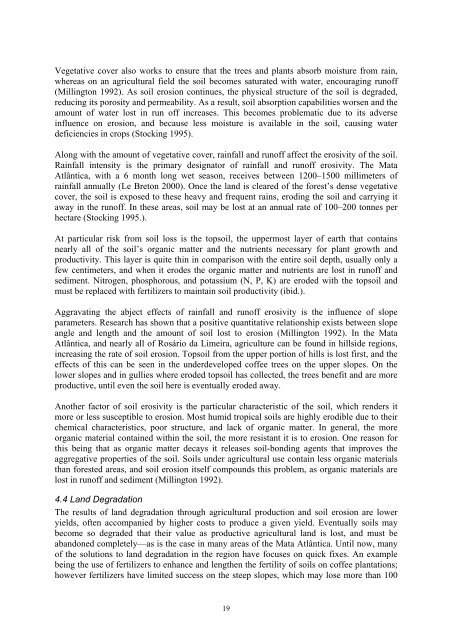Deforestation, Coffee Cultivation, and Land Degradation ... - lumes
Deforestation, Coffee Cultivation, and Land Degradation ... - lumes
Deforestation, Coffee Cultivation, and Land Degradation ... - lumes
You also want an ePaper? Increase the reach of your titles
YUMPU automatically turns print PDFs into web optimized ePapers that Google loves.
Vegetative cover also works to ensure that the trees <strong>and</strong> plants absorb moisture from rain,whereas on an agricultural field the soil becomes saturated with water, encouraging runoff(Millington 1992). As soil erosion continues, the physical structure of the soil is degraded,reducing its porosity <strong>and</strong> permeability. As a result, soil absorption capabilities worsen <strong>and</strong> theamount of water lost in run off increases. This becomes problematic due to its adverseinfluence on erosion, <strong>and</strong> because less moisture is available in the soil, causing waterdeficiencies in crops (Stocking 1995).Along with the amount of vegetative cover, rainfall <strong>and</strong> runoff affect the erosivity of the soil.Rainfall intensity is the primary designator of rainfall <strong>and</strong> runoff erosivity. The MataAtlântica, with a 6 month long wet season, receives between 1200–1500 millimeters ofrainfall annually (Le Breton 2000). Once the l<strong>and</strong> is cleared of the forest’s dense vegetativecover, the soil is exposed to these heavy <strong>and</strong> frequent rains, eroding the soil <strong>and</strong> carrying itaway in the runoff. In these areas, soil may be lost at an annual rate of 100–200 tonnes perhectare (Stocking 1995.).At particular risk from soil loss is the topsoil, the uppermost layer of earth that containsnearly all of the soil’s organic matter <strong>and</strong> the nutrients necessary for plant growth <strong>and</strong>productivity. This layer is quite thin in comparison with the entire soil depth, usually only afew centimeters, <strong>and</strong> when it erodes the organic matter <strong>and</strong> nutrients are lost in runoff <strong>and</strong>sediment. Nitrogen, phosphorous, <strong>and</strong> potassium (N, P, K) are eroded with the topsoil <strong>and</strong>must be replaced with fertilizers to maintain soil productivity (ibid.).Aggravating the abject effects of rainfall <strong>and</strong> runoff erosivity is the influence of slopeparameters. Research has shown that a positive quantitative relationship exists between slopeangle <strong>and</strong> length <strong>and</strong> the amount of soil lost to erosion (Millington 1992). In the MataAtlântica, <strong>and</strong> nearly all of Rosário da Limeira, agriculture can be found in hillside regions,increasing the rate of soil erosion. Topsoil from the upper portion of hills is lost first, <strong>and</strong> theeffects of this can be seen in the underdeveloped coffee trees on the upper slopes. On thelower slopes <strong>and</strong> in gullies where eroded topsoil has collected, the trees benefit <strong>and</strong> are moreproductive, until even the soil here is eventually eroded away.Another factor of soil erosivity is the particular characteristic of the soil, which renders itmore or less susceptible to erosion. Most humid tropical soils are highly erodible due to theirchemical characteristics, poor structure, <strong>and</strong> lack of organic matter. In general, the moreorganic material contained within the soil, the more resistant it is to erosion. One reason forthis being that as organic matter decays it releases soil-bonding agents that improves theaggregative properties of the soil. Soils under agricultural use contain less organic materialsthan forested areas, <strong>and</strong> soil erosion itself compounds this problem, as organic materials arelost in runoff <strong>and</strong> sediment (Millington 1992).4.4 L<strong>and</strong> <strong>Degradation</strong>The results of l<strong>and</strong> degradation through agricultural production <strong>and</strong> soil erosion are loweryields, often accompanied by higher costs to produce a given yield. Eventually soils maybecome so degraded that their value as productive agricultural l<strong>and</strong> is lost, <strong>and</strong> must beab<strong>and</strong>oned completely—as is the case in many areas of the Mata Atlântica. Until now, manyof the solutions to l<strong>and</strong> degradation in the region have focuses on quick fixes. An examplebeing the use of fertilizers to enhance <strong>and</strong> lengthen the fertility of soils on coffee plantations;however fertilizers have limited success on the steep slopes, which may lose more than 10019
















